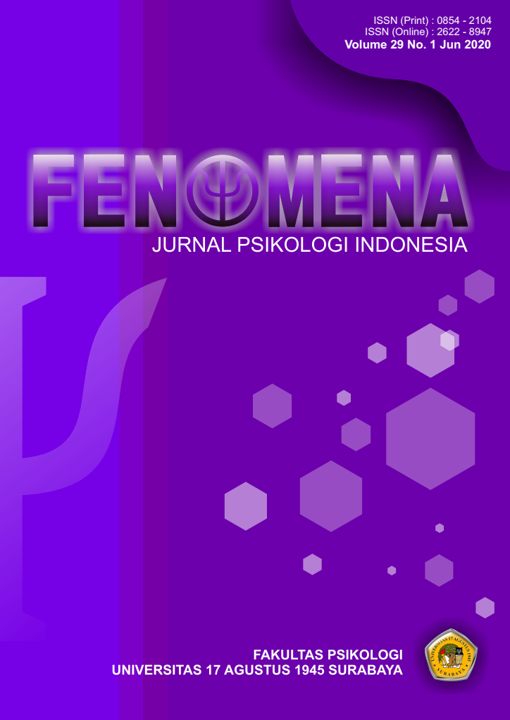Pengaruh Perundungan di Tempat Kerja pada Komitmen Organisasi dengan Organizational Strain sebagai Variabel Mediator
DOI:
https://doi.org/10.30996/fn.v29i1.3682Abstract
Penelitian ini bertujuan untuk mengetahui pengaruh perundungan di tempat kerja pada komitmen organisasi dengan organizational strain sebagai variabel mediator pada karyawan low management. Penelitian ini menggunakan metode kuantitatif. Populasi dalam penelitian ini adalah karyawan low management dengan masa kerja kurang dari 3 tahun. Pengumpulan data dilakukan dengan teknik survei melalui media sosial dan mendapatkan data dari 167 karyawan berstatus karyawan low management yang tersebar pada beberapa provinsi di Indonesia. Teknik sampling yang digunakan adalah gabungan dari accidental sampling dan snowball sampling. Perundungan di tempat kerja diukur dengan 9-item S-NAQ (Notelaers & Einarsen, 2008), organizational strain diukur dengan 8-item Job Stress Scale (Flirth, 2004), dan Komitmen Organisasi diukur melalui 24-item Organizational Commitment Scale (Allen & Meyer, 1990). Analisis data dilakukan menggunakan partial least square dengan bantuan program smartPLS. Berdasarkan hasil analisis data disimpulkan bahwa tidak terdapat pengaruh perundungan di tempat kerja terhadap komitmen organisasi, namun ditemukan perundungan di tempat kerja berpengaruh terhadap komitmen organisasi jika dimediasi oleh organizational strain. Hubungan ketiga variabel tersebut terbukti dan memediasi secara full atau full mediationDownloads
References
Allen, N. & Meyer, J. 1990. Measurement of Antecendents of Affective,Continuance and Normative commitment to Organizational. Journal of Occupational Psychology, 63: 1-8.
Allen, D.G., Bryant, P.C. & Vardaman, J.M. (2010). Retaining talent: Replacing Misconceptions with Evidencebased Strategies, The Academy of Management Perspectives, 24 (2), pp. 48-64. DOI: 10.5465/amp.24.2.48.
Bassman, E. (1992). Abuse in the Workplace: Management Remedies and Bottom Line Impact. Westport, Connecticut: Quorum.
Cooper, C. dan Robertson, I. (2001). Well-being in organizations. England: John Wiley & Sons, Ltd.
Demirtas, O. & Akdogan, A.A. (2014). The Effect of Ethical Leadership Behavior on Ethical Climate, Turnover Intention, and Affective Commitment, Journal of Business Ethics, pp. 1-9. DOI 10.1007/s10551-014-2196-6.
Dumitru, A., Burtaverde, V., & Mihaila, T. (2015). Exploring turnover, bullying at work and organizational commitment in the communication field. Romanian Journal of Experimental Applied Psychology, 6(4).
Einarsen, S., Hoel, H., & Notelaers, G. (2009). Measuring exposure to bullying and harassment at work: Validity, factor structure and psychometric properties of the Negative Acts Questionnaire-Revised. Work & stress, 23(1), 24-44.
Elangovan, A. R. (2001). Causal ordering of stress, satisfaction and commitment, and intention to quit: a structural equations analysis. Leadership & Organization Development Journal.
Fapohunda, T. M. (2013). Towards effective team building in the workplace. International Journal of Education and Research, 1(4), 1-12.
Firth, L., Mellor, D. J., Moore, K. A., & Loquet, C. (2004). How can managers reduce employee intention to quit?. Journal of managerial psychology.
Ghozali, I., & Latan, H. (2014). Partial Least Squares konsep, metode dan Aplikasi menggunakan program WarpPLS 4.0. Semarang: Badan Penerbit Universitas Diponegoro.
Hamid, S. (2014). Manajemen sumber daya manusia lanjutan. Deepublish.
Holtom, B.C., Mithell, T.R., Lee, T.W., & Eberly, T.B. (2008). Turnover and retention research: A glance at the past, a closer review of the present, and a venture into the future. The Academy of Management Annals. Vol. 2, No. 1, 2008, 231–274. DOI: 10.1080/19416520802211552.
Kuvaas, B., & Dysvik, A. (2010). Exploring alternative relationships between perceived investment in employee development, perceived supervisor support and employee outcomes. Human Resource Management Journal, 20(2), 138-156. DOI: 10.1111/j.1748-8583.2009.00120.x.
Mathis, R. L. dan Jackson,(2011). Human resource management. Cengage Learnin. USA
Mattice& Garman,(2011). Building a culture of respect: Managing bullying at work (pp. 135–154). London:Taylor & Francis.
McCarthy, P, Mayhew, C., Barker, M., and Sheehan, M. 2003 Bullying and Occupational Violence in tertiary education: Risk factors, perpetrators and prevention, Journal of Occupational Health and Safety Australia and New Zealand, 19, 4, pp.319-26
Mitchell, T., dkk. (2001). Why people stay: Using job embeddedness to predict voluntary turnover. Academy of Management Journal, Vol. 4 (6).
Notelaers, G., & Einarsen, S. (2008, June). The construction and validation of the Short-Negative Acts Questionnaire. In Comunicación en el 6th International Conference on Workplace Bullying (pp. 4-6).
Oghojafor, B. A., & Adebakin, M. A. (2012). Assessment of job design and job satisfaction among doctors and nurses in Lagos, Nigeria hospitals. African Journal of Business Management, 6(48), 11702.
Putra, D.K., dan Pujiastuti, I.S.S. (2015). Pengaruh Workplace Bullying Pada Kepuasan Kerja, Komitmen Organisasi, Dan Niat Untuk Berpindah Dengan Strain Sebagai Variabel Mediasi. Fokus Manajerial, 13(2): 177-188.
Randi L. Sims, Peng Sun, (2012) "Witnessing work place bullying and the Chinese manufacturing emplo-yee", Journal of Managerial Psychology, Vol. 27 Iss: 1, pp.9 – 26.
Sanjaya, I. K. E., & Indrawati, A. D. (2014). Pengaruh Kompetensi, Kompensasi, dan Lingkungan Kerja terhadap Kinerja Karyawan pada PT. Pande Agung Segara Dewata. E-Jurnal Manajemen, 3(1).
Vartia, M. A. (2001). Consequences of workplace bullying with respect to the well-being of its targets and the observers of bullying. Scandinavian journal of work, environment & health, 63-69.
Vega, G., & Comer, D. R. (2005). Sticks and stones may break your bones, but words can break your spirit: Bullying in the workplace. Journal of business ethics, 58(1-3), 101-109.
Downloads
Published
Issue
Section
License
Authors retain copyright and grant the journal right of first publication with the work simultaneously licensed under a Creative Commons Attribution 4.0 International License that allows others to share the work with an acknowledgment of the work's authorship and initial publication in this journal.






